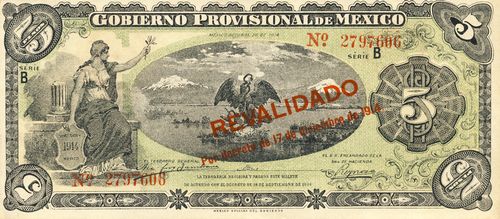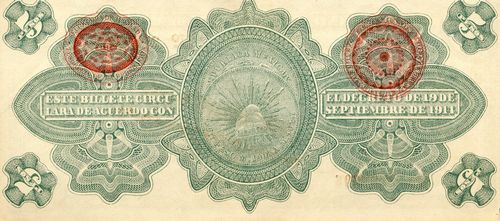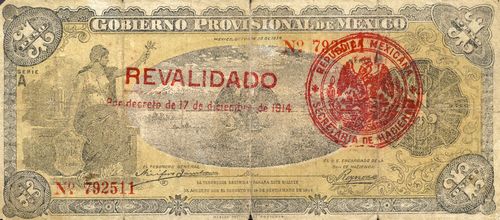Revalidations on Gobierno Provisional notes
After the break with Carranza Convention forces, basically the División del Norte, advanced from Aguascalientes and occupied the capital on 3 December 1914, with Villa and Zapata making a triumphal entrance three days later. Carranza withdrew to Veracruz.
In December 1914 the Conventionist provisional president, Eulalio Gutiérrez, issued a decree stating that, as the Carrancistas, when evacuating the capital, has taken the plates (placas y piedras) for the Gobierno Provisional issue and intended to continue issuing notes, and it would be unjust for the National Treasury to take on such an obligation, he was declaring null and void any Gobierno Provisional notes that were not included in the list he was publishing and holders were to exchange them for notes of the same issue that had been overprinted with 'REVALIDADO - Por decreto de 17 de diciembre de 1914' on the reverse in red ink. Holders of notes were given ten days in the capital and twenty days outside the capital to hand them in and the exchange would take place in the Tesorería de la Federación in the capital and in the Jefaturas de Hacienda and Administraciones Principales and Subalternas de la Renta del Timbre outside.
The period for revalidation was extended on 30 December and then on 23 January 1915 President Roque González Garza modified the 17 December decree and announced that the period for restamping or revalidating the notes was extended to 15 March. At the same time he decreed that to make the widespread Villista currency acceptable the Secretaría de Hacienda would also revalidate the sábanas.
On 12 February González Garza, from Cuernavaca, extended the period for revalidation for three months, during which the notes would continue to be of forced circulation, even if not revalidatedThe previous day, 11 February, General Emiliano Zapata from Iguala had informed the military commanders under his command (in Chilpancingo, Tixtla, Chilapa, Tlapa, Huamuxtitlán, Ayutla, Teloloápam, Taxco, Coyuca de Catalán, Atzcapozalco and Huitzuco (Colección revolución, caja 3, exp 48, folleto 2).
On 11 March González Garza and the Conventionists left Cuernavaca and re-entered Mexico City. The Convention immediately declared the Carranza currency which had been in forced circulation null and without value.
As stated, the time limit in the original decree of 17 December had been extended for three months from 12 February 1915, during which period notes continued to be of forced circulation even if they did not have the revalidation and on 11 May González Garza extended the period until 12 July. All this tended to defeat the object of the exercise.
The following revalidations are known.
Mexico City
Presumably, the revalidation of Gobierno Provisional de México began a few days after the 17 December decree. Note that, contrary to the text of the decree, most revalidations were applied to the face of the note with a seal placed on the reverse. The most common revalidation was 'REVALIDADO / Por decreto de 17 de diciembre de 1914'.


This revalidation was counterfeited, at least on sábanas.
On 26 January the authorities in Mexico City began the exchanging of notes for REVALIDADO sábanas and Gobierno Provisional, giving preference to the sábanas as they were causing the greatest difficulties and large crowds gathered outside the Pagaduría de las Escuelas Normales para Profesores, in Mexico City, to change or validate their notesEl Sol, 25 January 1915: La Convención, 26 January 1915. The Tesorero General de la Federación said the exchange would take place not only at that Pagaduría but also at other pagadurías oficiales in the capital and Federal DistrictEl Radical, 25 January 1915. However, Obregon’s forces arrived in Mexico City on 28 January and held it until 11 March.
When González Garza left for Cuernavaca on 26 January, he left behind the revalidating machine.
After the Conventionists returned, on 22 March the new authorities began the revalidation and exchange of notes, at the counters of the Tesorería de la Federacion, on the north side of the central patio of the Palacio Nacional. The first window was for quantities greater than ten pesos, where one received a receipt to collect the notes again in 48 hours. At the other window, amounts under ten pesos were changed immediatelyMexican Herald, 23 March 1915. On 23 March more than two thousand people gathered at the offices to get their notes validatedEl Radical, 23 March 1915. However, the innumerable counterfeits delayed the work of the expertsEl Radical, 29 March 1915.

A legend 'REVALIDADO / Por decreto de 17 de diciembre de 1914' and a red seal with 'REPUBLICA MEXICANA - SECRETARIA DE HACIENDA'
On 11 February 1915 Carranza’s government in Veracruz stated that the Gobierno Provisional note with the “Revalidados por decreto de 17 de diciembre de 1914” and “Secretaría de Hacienda” overstamps were still legitimate – hardly surprising as these were originally a Carrancista issueEl Dictamen, Año XVII, Núm. 1419, 12 February 1915.
